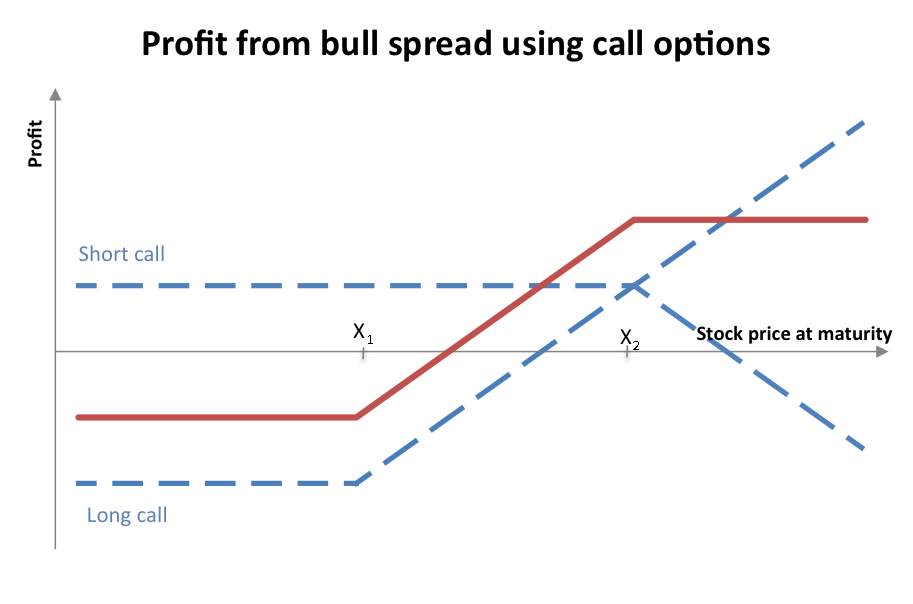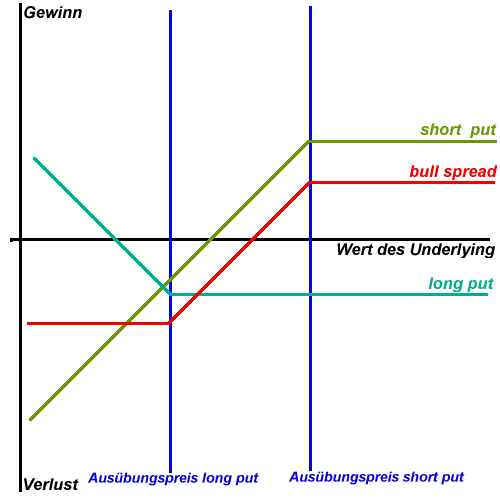Vertical Put Spreads
Post on: 12 Апрель, 2015 No Comment

A strategy consisting of the purchase of a put option with one expiration date and strike price and the simultaneous sale of another put with the same expiration date, but a different strike price. Depending on whether the purchased put has a higher or lower strike than the sold put, a vertical put spread can generally be profitable if the underlying stock or index rises (a bull vertical put spread) or falls (a bear vertical put spread) sufficiently.
Bull Vertical Put Spread
Similar to the Bull Call Spread, the Bull Put Spread strategy may allow the investor to profit from an upward movement in the underlying security. To utilize this technique, the investor sells puts at one strike and buys puts at a lower strike that share the same expiration date. The high-strike puts have higher premiums than the low-strike puts. As a result, the investor will receive a net inflow of capital since the price of the options sold exceeds the price of the options purchased. Consequently, bull put spreads are often referred to as ‘credit’ spreads. To achieve maximum profit, the underlying security price must rise above the strike price of the short (written) put at expiration, rendering both puts worthless.
For use when investor anticipates:
Upward market direction / security appreciation
Maximum Loss: The difference between the strike prices less the amount received to establish the spread*
Maximum Profit: Net premium received
Objective*:
Speculative gain
*The maximum loss on a bull put spread is limited as long as, and only as long as, the integrity of the spread is maintained. If the investor trades out of or exercises the low-strike put, the maximum loss is no longer limited to the premium outlay. There is an additional risk associated with the expiration weekend. If the short put is assigned, while the long is not auto-exercised (because, for example, the stock closes between the two strikes) the investor ends up with a long position in the stock. Bad news during the weekend could force even greater losses on the investor before he can exit the long equity position.

EXAMPLE (Bull Vertical Put Spread)
Currently, XYZ trades at $25/share. The investor employs the spread strategy selling one in-the-money put (Strike $30) for $6.00/share and buying one out-of-the-money put (Strike $20.00) for $1.00/share. Using this strategy, the investor receives a cash credit of the difference between the premiums received and the premiums paid (6-1=$5 or $500) and this is the maximum profit the investor can earn. If the stock rises to $30.00/share, the long and short put positions expire worthless and the investor keeps the net premium received. The maximum loss is the difference between the option strikes, less the call premium received (30-20-5 = $5 or $500) (see * above). The breakeven price of 25 is calculated by subtracting the net credit of the spread from the strike price of the short option.
Bear Vertical Put Spreads
The Bear Put Spread may allow an investor to profit from downward movements in the underlying security. It uses exactly the opposite structure of the Bull Vertical Put Spread and requires the investor to buy a high-strike put and sell a low-strike put (with a lower premium). The sale of the less expensive, out-of-the-money put will partly offset the cost of purchasing the in-the-money put. The maximum the investor can profit is the difference between the strike prices used to create the spread less the cost of establishing the spread. If the security rises in value, the maximum the investor can lose is the difference between the premium paid for the long put and the premium received from the short put.
For use when investor anticipates:
Declining market/security depreciation














